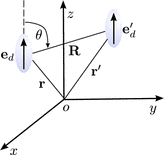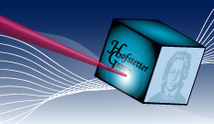Dipolar gases
Recently in the field of ultracold atom physics, systems made up of ultracold atoms or molecules with large dipole-dipole interactions attracted considerable interests. Dipole-dipole interactions can either originate from magnetic dipole moments of the atoms, which are of the order of a few Bohr magneton or from the electric dipole moments of the hetero-nuclear polar molecules, which are of the order of a Debye. Dipolar interaction are both long-range and anisotropic as it can be easily seen from the form of the potential between two interacting polarized dipoles
|
|
The symultaneous presence of both these characters, makes dipolar systems unique and very different from the usual ultracold systems, where the interactions are short-ranged and isotropic. Several interesting properties have been found both theoretically and experimentally in dipolar systems. For trapped dipolar Bose-Einstein condensates (BEC), stable condensates have been found to have a biconcave shape, resembling that of a red blood cell [1] |
The symultaneous presence of both these characters, makes dipolar systems unique and very different from the usual ultracold systems, where the interactions are short-ranged and isotropic. Several interesting properties have been found both theoretically and experimentally in dipolar systems. For trapped dipolar Bose-Einstein condensates (BEC), stable condensates have been found to have a biconcave shape, resembling that of a red blood cell [1]
 |
What is even more interesting is that when the condensate in presence of large dipolar interactions becomes unstable, it will collapse forming a d-wave pattern during its collapse process [2]

When a dipolar BEC is loaded in a optical lattice, many interesting phases are theoretically predicted in this system, including the supersolid phase which combines both diagonal and off-diagonal long-range order [3],[4]
For fast rotating quasi-2D dipolar Fermi gases, Quantum-Hall-like states are theoretically predicted in these system [5], [6]. For more details of the interesting properties of ultracold dipolar gases, please check the reference listed below.
[1] S. Ronen, D. C. E. Bortolotti, and J. L. Bohn, Phys. Rev. Lett. 98, 030406 (2007).
[2] T. Lahaye, J. Metz, B. Frohlich, T. Koch, M. Meister, A. Griesmaier, T. Pfau, H. Saito, Y. Kawaguchi, and M. Ueda, Phys. Rev. Lett. 101, 080401 (2008).
[3] K. Goral, L. Santos, M. Lewenstein, Phys. Rev. Lett. 88 170406 (2002).
[4] S. Yi, T. Li, C.P. Sun, Phys. Rev. Lett. 98 260405 (2007).
[5] M. A. Baranov, K. Osterloh, and M. Lewenstein, Phys. Rev. Lett. 94, 070404 (2005).
[6] K. Osterloh, N. Barberan, and M. Lewenstein, ibid. 99, 160403 (2007).







